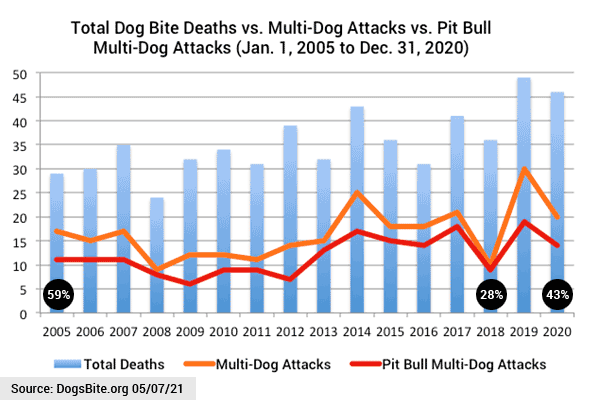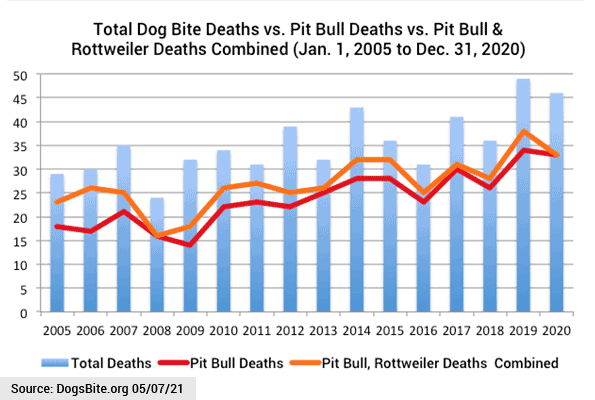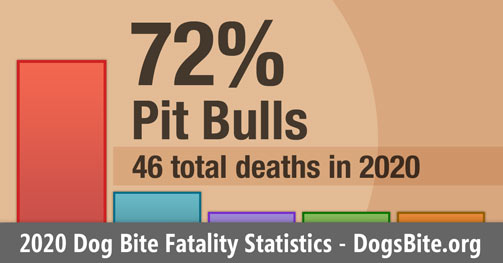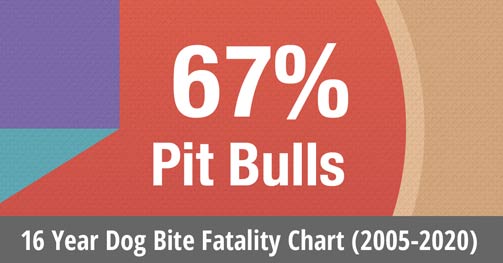Fatal Dog Attack Statistics
DogsBite.org recorded 46 fatal dog attacks in 2020. Pit bulls contributed to 72% (33) of these deaths, over 16 times higher than any other dog breed. During this pandemic year, media reports of fatal dog maulings fell by 45%. In response, our nonprofit sent out 30 FOIAs to various offices and uncovered 6 unreported deaths in 2020. The last time the CDC collected breed data about dogs involved in fatal human attacks was 1998. Pit bulls have killed over 440 Americans since.
- 46 U.S. dog bite-related fatalities occurred in 2020. Despite being regulated in Military Housing areas and over 900 U.S. cities, pit bulls contributed to 72% (33) of these deaths. Pit bulls make up about 6.2% of the total U.S. dog population.
- During the 16-year period of 2005 to 2020, canines killed 568 Americans. Two dog breeds, pit bulls (380) and rottweilers (51), contributed to 76% (431) of these deaths. 37 different dog breeds were involved in the remaining fatal dog maulings.
- In 2020, the combination of pit bulls (33), additional bull breeds (4) and mastiff-type guard dogs and war dogs (3) -- the types used to create "baiting" bull breeds and fighting breeds -- accounted for 87% (40) of all dog bite-related deaths.
- See full report: 2020 U.S. Dog Bite Fatality Statistics - DogsBite.org
- News release: Nonprofit Releases 2020 Dog Bite Fatality Statistics - Attacks by Bull Breeds Increase and Trends from the 16 Year Data Set
Data Collection Method: How We Collect U.S. Dog Bite Fatality Data
Discussion Notes
DogsBite.org - During 2020, new trends arose, including a rise of reported fatal dog attacks without breed data -- despite many of these dogs being taken into custody -- and a rise of unreported fatal dog attacks. Bull breed attacks surged in 2020, as did multi-victim attacks (a new tracking category) and adult males killed by dogs. Multi-dog attacks involving 2 or more dogs fell in 2020, but fatal pack attacks involving 4 or more dogs increased, despite Covid-19 lockdowns.
A single year of dog bite fatalities may or may not indicate new trends. This is in addition to the Covid-19 pandemic, which forced behavior changes upon many Americans. Given the small number of fatal dog maulings in any single year, it's unknown which parts of our 2020 data, if any, can be seen as a reflection of Covid-19. One would expect to see a rise in family dog attacks and a reduction in off-property attacks -- both aspects did occur in 2020, but without any significance.
Unreported Deaths and Breeds
Our nonprofit uncovered 6 fully or initially unreported dog bite fatalities that occurred in 2020. For each of these deaths, we also confirmed the breed of dog involved. Along with discovering 6 deaths with breed data, we obtained breed data in 4 other deaths (case count=10). Of media reported deaths, 5 cases had "total" unreleased breed data. Thus, there was a total of 15 deaths, 33% of all deaths, that otherwise would not have breed data had we not followed up with FOIAs.
Given the high number of fatal dog attacks with no breed data in 2020, we analyzed the characteristics of them (case count=9) to see if there were commonalities. There were, primarily, adult females killed in pack attacks. We also examined the characteristics of unreported fatal attacks from 2005 to 2020 (case count=18) that we have uncovered in FOIAs over the last decade. There were commonalities in this data too, including all deaths involving bull breeds.
Characteristics of Reported Fatal Attacks with No Breed Data in 2020
- Total case count = 9
- The most likely fatal dog attack with no breed data reported in 2020 involved a female ≥ 36 years old killed by a pack of 4 or more dogs (6 of 9 cases), likely involving pit bulls, and largely occurred in the Southern United States in a rural area.
- Of the 6 fatal pack attacks, 100% of victims were females ≥ 36 years old and after research and FOIA requests, 50% of these cases (3 of 6) involved pit bulls. Most attacks occurred in the Southern United States, 67% (4 of 6), and in rural areas, 67%.
- The 3 other cases include: 1 infant killed by a dog in military housing in Hawaii, 1 teenager killed by 2 or more dogs in rural Kentucky and 1 senior citizen killed by a family pit bull in Florida whose owner had four adult pit bulls in the household and nine pit bull puppies.
- Of the 568 people killed by dogs since 2005, only 15% involved a pack of 4 or more dogs. Under the conditions of this small subset, pack attacks weighed in at 67%.
Characteristics of Unreported Fatal Dog Attacks (2005 to 2020)
- Total case count = 18
- The most likely unreported fatal dog attack from 2005 to 2020 is an adult ≥ 40 years old killed by a single or pair of family pit bulls in a city area in an anti-BSL state (a state with a preemption law prohibiting local governments from enacting breed-specific laws).
- 78% (14 of 18) of victims were ≥ 40 years old. 83% (15) of cases involved pit bulls, and of that 73% (11 of 15) involved a single or pair of family pit bulls attacking.
- 83% of attacks occurred in a city area (15 of 18) and 67% (12) occurred in anti-BSL states, primarily, California, Florida, Nevada and Texas in our data set (12 of 18).
- 94% (17) of cases involved 1 or 2 dogs; 89% of cases occurred on the owner's property; and there was a slight predominance of male victims, 56%.
Despite the strange pandemic year of 2020, for over a decade our FOIAs have consistently revealed that pit bull breeds are the most likely to be involved in unreported lethal attacks. These 18 unreported deaths include: pit bulls (involved in 15 deaths), American bulldogs (3) and a bull terrier (1).1 Only two other breeds participated in these attacks, 1 mixed-breed and 1 shepherd-mix. Our data set contains little evidence that fatal attacks by other breeds are going undetected.
Non-Bull Breed Deaths in 2020
2020 marks a year when so many different bull breeds inflicted a fatal attack that we had to use different language in our statistics. "In 2020, the combination of pit bulls (33), additional bull breeds (4)" and "When breed was known, only 3 deaths did not involve bull breed or mastiff-type dogs." Those 3 deaths included a single German shepherd (attributed to 2 deaths) and a single Belgian malinois (1 death). All other deaths involved pit bull breeds and mastiff-type dogs.
These breeds include: pit bulls (involved in 33 deaths), American bulldogs (involved in 2 deaths), mastiff/bullmastiff (involved in 2 deaths), American bully-mix (involved in 1 death), a bull terrier (involved in 1 death) and a cane corso-pit bull mix (involved in 1 death). When breed was known, every single adult victim ≥ 25 years old (24 cases) was killed by one of these pit bull breeds or mastiff-type dogs. During 2020, there were no recorded rottweiler-inflicted dog bite fatalities.
New Tracking Categories
In 2020, we officially began tracking multi-victim fatal dog attacks. 15% (7) of fatal dog attacks involved the dog(s) injuring additional people at the scene. In this category, 71% (5 of 7) of attacks involved injuring 2 or more people beyond the person killed; 86% (6) of attacks required these victims to be treated at a hospital; and 100% of these attacks were carried out by pit bulls (7), of which 86% involved a single or pair of family pit bulls attacking household members.
86% (6 of 7) of attacks resulted in multiple adult victims, ≥ 19 years old; and 1 attack involved 2 adults severely injured while protecting a baby.
In 2020, we also began tracking deviant/habitual behaviors, largely using criteria from Barnes and Boat, 2006 (repeated animal control violations, aggressive crimes, drugs, alcohol, domestic violence, crimes involving children and firearms), and when an "argument" preceded a fatal attack. Notably, over half of the multi-victim attacks, 57% (4 of 7), fell into this category. Overall, 20% (9 of 46) of dog bite fatalities in 2020 fell into this new category. All 9 cases involved pit bulls.
Unlike Barnes and Boat, who examined dog owners within one county in Ohio by primarily accessing databases, there are no national databases. These areas are rarely mentioned in news reports either, unless police release details like, "fourth call to this home in the past five years." So, we have to strongly suspect this deviant behavior, as we did in the case of Benjamin Spence, who has a significant rap sheet. It's far from a perfect system, but the data is too important to ignore.
Rise of Male Deaths in 2020
Since 2018, we have been tracking the increase of adult females ≥ 30 years old killed by dogs, primarily pit bulls. In 2020, we saw a rise in adult males killed by pit bulls. All males ≥ 25 years old killed by dogs in 2020 (12 deaths) were killed by pit bulls, except for 70-year old Frederick Shew, who was killed by his known aggressive mastiff, named "Thor." In fact, 3 male victims, ages 25, 26 and 27 -- all rare ages in fatal dog maulings -- were fatally attacked by pit bulls in 2020.
Stunningly, two of those deaths resulted in the rarest of all criminal charges -- second-degree murder charges for using the dog as a dangerous weapon. This type of charge is so rare, we only know of one other case, the death of Angela "Dolly" Kaplan in 1992. Jeffrey Mann was convicted of murder for holding Kaplan down while his pit bull inflicted over 100 bites to her. In 2018, we wrote to the Ohio Parole Board to ensure Mann stayed in prison. His parole was again denied.
In November, Benjamin Spence was charged with second-degree murder after ordering his pit bulls to attack 26-year old Curtis Wickham. Spence was also charged with assault with a deadly weapon after he threw a TV set at Wickham, nearly hitting his head, while Wickham lay dying on the ground from injuries inflicted by Spence's three pit bulls. Court records show that the plea cut off date for Spence is September 9, 2021. A jury trial is scheduled for October 11, 2021.
Multi-Dog Attacks Fall
Attacks inflicted by multiple dogs fell in 2020 to 43% (20), dropping below the 15-year average of 47%. Multi-dog attacks involving 2 or more pit bulls accounted for 70% (14 of 20) of these attacks. Attacks inflicted by single dogs accounted for 57% (26) of all dog bite fatalities. Notably, pack attacks involving 4 or more dogs accounted for 17% of all deaths, which is slightly above the 15-year average of 14.6%. Despite Covid-19 restrictions, fatal pack attacks did not diminish in 2020.2
The chart depicting 16 years of multi-dog fatal attacks shows a steep plunge in 2018. There may be no rhyme or reason. However, given what is now known about unreported fatalities, there could be undetected fatalities during 2018 and 2020 involving a pair of family pit bulls. We did discover one of those cases already, the death of elderly "Coco" in Florida. Those two family pit bulls viciously attacked three adult family members, hospitalizing all three. Coco did not survive.

Summary
Overall, dog bite fatalities during 2020 were highly dominated by bull breeds and mastiff-type dogs. When breed was known, only 3 deaths tracked did not involve these breeds. Reported fatal dog attacks lacking breed data and unreported fatal dog attacks also characterized the year. Thus far in 2021, the underreporting of fatal dog maulings is also occurring. Reported fatalities are down by 38% this year (Jan 1-May 25, 2021) compared to pre-Covid 2019 (Jan 1-May 25, 2019).
This year, due to the growing number of unreported dog bite fatalities our nonprofit has obtained through FOIAs over the last decade, we were able to identify common characteristics among them. The most likely unreported fatal dog attack from 2005 to 2020 is an adult ≥ 40 years old killed by a single or pair of family pit bulls in a city area in an anti-BSL state, primarily California, Florida, Nevada and Texas in our data set. There was also a slight predominance of male victims.
One can consider these characteristics when reviewing the missing adult cases in the 50-69 age groups we discovered in CDC Wonder database.
Despite adult victims leading fatal dog attacks in our multi-year data set, CDC Wonder data shows that many more adult deaths are undetected by the media. CDC data shows 151 deaths in the 50-69 age groups from 2005 through 2019. Our data shows 96 deaths in this same period. The 70 and older age groups also show more deaths in CDC data (124 v. 91). However, some elderly deaths in CDC data are "struck by dog" deaths, which would be excluded from our data set.3
Additional Annual and Combined Year Statistical Graphics (2005 to 2020)



Data Collection Method: How We Collect U.S. Dog Bite Fatality Data
2As we were preparing this report, the 24th Navajo Nation Council issued a release on May 27, 2021 saying that three people were killed by dogs on the Nation over the last year. This data has not yet been added to our 16 year data set, nor do we currently know the dates or details of those fatal attacks. However, all three attacks were likely pack attacks. Meaning that the occurrence of fatal pack attacks during the pandemic was even more pronounced.
3We have recorded 8 "struck by dogs" deaths since 2005, which are not included in our data set.
Related items:
2020 Fatal Dog Attack Breed Identification Photographs - DogsBite.org
Recent multi-year reports:

Thank you, Colleen, for taking the time and effort to compile this comprehensive and valuable report. Why do fatal maulings go unreported? Because local entities are highly motivated to cover up the unreasonably elevated risk of grave threat that stalks their communities. Imagine how many non-fatal, severe maulings go unreported. There is a huge, concerted effort on the part of the all-powerful Dangerous Canine Industry (DCI) and all layers of government to prevent the American public from being informed of the fatal and severe non-fatal mauling statistics that make clear the extent of this out of control public health crisis.
Again, thank you for being a voice to inform all people of the unreasonably elevated risk of grave threat that dangerous breed canines and their owners and the DCI pose.
Wow, amazing job Colleen. Good info those areas considering BSL so they can make informed decisions.
Passing BSL is one thing. Getting it enforced is another thing entirely.
Even with less than stellar enforcement, BSL *does* make things easier.
While most pitbull owners do not comply with the muzzle laws, they do know they could be forced to, or their dogs removed so that had two results, here:
1) Most people who still get pitbulls are a great deal more careful than they were before BSL. No more pitbull owners letting their dogs run loose because if they do and the dog is picked up–it will can be euthanized, and it certainly will never be returned.
2) Because of the hassles of pitbull ownership, far fewer people purchase pitbulls in a BSL area.
So I’d say it’s still worth fighting for. Having laws against theft doesn’t mean nobody every steals anything or that it’s always prosecuted. It does mean there’s a public acknowledgement that there’s something wrong with theivery.
I would like to point out that within two months, I became the victim of mail theft, identity theft, and burglary. Still traumatized by the experience, and it happened back in 2018-19.
Despite the fact that I gave numerous tips to the local police, and, in the cases of the thefts of my mail and identity, federal authorities, no one was ever arrested or charged.
Oh, the police did find someone who tried to pawn some of my property, but our local county attorney’s office declined to prosecution.
So, color me skeptical about the mere presence of BSL on the books. It needs enforcement AND prosecution.
You have to start somewhere, is my point. At least with some legislation on the books neighbours can call up Animal services and register a complaint. If something is on the books then at least you have somewhere to start to hold authorities accountable.
Of course strong enforcement is preferable.
We have BSL here. Enforcement seems to come and go. There’s enough risk of it though, that pitbull owners tend to be far more cautious than they were before it was passed. Used to be loose pitbulls wandering around with far more frequency, back then.
The muzzle laws are rarely enforced, sadly. The loose dog enforcement seems to be more stringent.
Having nothing means you have zero legs to stand on to stop the proliferation of pitbulls. One thing for sure, much as there’s been a bit of increase in them lately, there’s nowhere near the numbers we had here before it happened.
All you need to see is the numbers. Clearly with almost no pitbull attacks in Ontario in the past few years–it’s done something.
Well done, Colleen!
Amazing work, as always, Colleen. Let’s hope this trend of unreported fatal pit bull (dog) attacks does not continue. You have worked so hard to track down these events because they matter. More people need to say enough is enough.
A woman aged late 30’s — early 40’s, was mauled to death by 3 dogs (mixed- breed) in Queensland, Aust on 8th June, 2021… she was ‘looking after’ the dogs for a friend… hard to find details 🤨 of course it is called “a tragic accident” …an ‘accident’ waiting to happen if you ask me
If a human being is not positioned within proximity to a steep precipice, a so-called “tragic accident” directly caused by the circumstances of that situation can not occur.
If a human being is not positioned within proximity to a dangerous breed canine, a so-called “tragic accident” directly caused by the circumstances of that situation can not occur.
Looks like they were not Beagle mixes:
“…The dogs, believed to be cross breeds but predominately pitbull…”
https://nz.news.yahoo.com/pictured-woman-mauled-to-death-by-three-dogs-in-queensland-040327488.html
Speaking of Beagles, Richard.
There’s pantloads of abused beagles in medical research and ain’t no billion dollar lobbies and hundreds of rescues/sanctuaries sucking up money to help them.
Of course we all know there’d be a shortage of medical researchers if they hauled pitbulls in and out of cages to experiment on them.
Nor is there a ton of public attention or lobbyists screeching that “Beagles are Nanny Dogs and The Most Abused Doggos Out There”